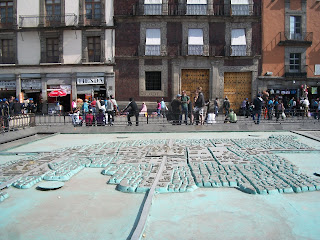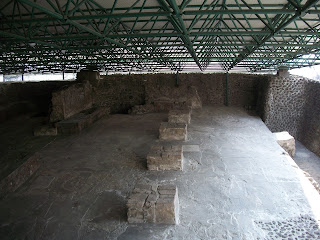We began our day visiting Iturbide’s home? Palace? He declared himself king until he was ousted
by Santa Anna and Mexican independence six months later. The building is now
owned by a Mexican Bank (Bankomex- they are everywhere.) There was an
exhibition of ornate silver works- jewelry, kitchen ware, various vessels of
all shapes and sizes, saddles and even traditional Mexican costume with silver
decoration. Featured artists were from Taxco, a town know for silver work and
Mexico City.
The main feature of the day was Temple Major and the Aztec
history, Aztec art and of course the Aztec ruins of Teocalli- the vast temple. On the
east side of the great cathedral is a large three dimensional map of the city
of Tenochitilan- the future Ciudad di Mexico.
A couple hundred islands surrounded by a lake. The islands are actually
next to canals that crisscross the land. Near the center is a larger island
with several pyramids. Also to the west a bit is another group of pyramids. I
never found out about those pyramids. But as Truckee and I were conversing a
gentleman approached us and asked us if we wanted to hear a talk on the Aztec
city. Many in the city make a living, performing little services like this for
tourists. I asked him how much. He said that we could pay what we thought that
it was worth. He gave us a great deal of
information about the makings of the city of Tenochitilan, of the various Aztec
rulers and of the entry of Spanish into the city. I loved this man’s clear thick
accent. When he pronounced Aztec names like Huizoopochtli, the Aztec war god,
he pronounced them slowly and with care Hoo-zoo—pocch- chet- teel-li. He did
not keep to his word, but charged us $100 pesos for the lecture.
We entered the vast ruins. In 1978 an electrical worker
excavating the property where we stood, came upon the head of a giant snake. It
turned out that the snake was one of three that guarded the main giant Aztec temple
of the city. It was then that the city began its excavations of the site. To get an idea of design of the temple, one
must imagine a series of shells within each other. It was actually a series of
five temples built within each other. The first (perhaps it is the second.) was built in about 1400 CE and is the one in
tact today. It is in tack because as the Spanish razed the temple to the
ground, rubble and the shells of these subsequent temples covered the remains
of the one we see in the excavation.
It is thought that there is yet another temple beneath the
one we saw, but the water table in Mexico City does not allow excavation. As each succeeding ruler build another layer
on top of the preceeding temple, they filled the space in between with gravel-
along with the gifts of tribute from the lands all around Mexico. Generally the sacrifices were made at the top
of the pyramid. The blood was saved and
thought to be sacred. We know that the heart were pulled out and put in a
sacred place.
See below: The Priest's Ceremonial Room
Temple Major contains a vast number of artifacts from the
diggings at this site. They fall into several categories, sacred instruments
used by the priests, icons and statues of various Aztec dieties along with
their mythical stories and the offerings of communities from all over Mexico-
masks, icons, beads, ceremonial items, jewelry, anything of value that these
people would give their conquerors. It
is the number and variety of these items that impressed me most.
In looking at the geography of the area I was amazed at the
size of the giant lake that surrounded the city. And that city was not the only
one. Probably about 100 different
communities thrived on the lake living in similar island cites, many connected
with one another. Many of these
communities had their own pyramids of similar design.
When the Spanish came, they came as conquerors. They banned anyone of native blood from the
city. They destroyed the temple and built their own temples and estates over
them. They were the conquistadors.
Miclantecuhtli, the God of Death, his skinny threatening
frame beckons people to the underworld. His liver hangs out as that was the
organ thought by the Aztecs to be closely associated with the underworld.












No comments:
Post a Comment